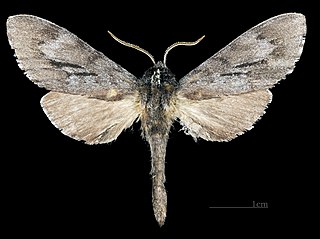
Lapara coniferarum, the southern pine sphinx, is a species of sphinx moth. It was first described by James Edward Smith in 1797. The species is listed as threatened in Connecticut.

Acronicta lanceolaria, the lanceolate dagger moth or pointed dagger, is a moth of the family Noctuidae. The species was first described by Augustus Radcliffe Grote in 1875. It is found in North America, from Nova Scotia to British Columbia. It is listed as a species of special concern and believed extirpated in the US state of Connecticut.
Exyra fax, the pitcher plant moth, is a moth of the family Noctuidae. It is mainly found on the Atlantic Coastal Plain and Great Lakes region of eastern North America (from Manitoba through Michigan to Nova Scotia and Maine south to Georgia. The species is listed as threatened in Connecticut.

Argyrostrotis anilis, the short-lined chocolate, is a moth of the family Noctuidae. The species was first described by Dru Drury in 1773. It is found in North America from Quebec and Ontario, down through the eastern United States to Florida and Texas. It is listed as a species of special concern in the state of Connecticut.

Acronicta fragilis, the fragile dagger moth, is a moth of the family Noctuidae. The species was first described by Achille Guenée in 1852. It is found in North America from Newfoundland to Florida, west across Canada, south to Kentucky and Minnesota. It is listed as a species of special concern in the US state of Connecticut.

Catocala pretiosa, the precious underwing, is a moth of the family Erebidae. The species was first described by Joseph Albert Lintner in 1876. It was included in Catocala crataegi by many authors, but recently it has been revalidated as a distinct species. The subspecies of pretiosa is listed as a species of special concern and believed extirpated in the US state of Connecticut.

Catocala herodias, the Herodias underwing or Gerhard's underwing, is a moth of the family Erebidae. The species was first described by Strecker in 1876. The nominate form is found in the US states of Texas and Oklahoma. Subspecies Catocala herodias gerhardi is found from Massachusetts, Connecticut, New York to Virginia. The gerhardi subspecies is listed as endangered in Connecticut.

Acronicta falcula, the corylus dagger moth, is a moth of the family Noctuidae. The species was first described by Augustus Radcliffe Grote in 1877. It is found in the United States and Canada from southern New England to southern Manitoba and Iowa. Recently seen from Wisconsin, Connecticut, Rhode Island, New York and Michigan. It is reported as rare in Ohio. It is listed as a species of special concern in the US state of Connecticut.

The pink star moth is a species of moth of the family Noctuidae. It is found from southern Maine to Florida, west to Missouri and Texas.
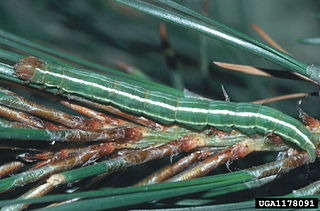
Zale curema, the black-eyed zale or northeastern pine zale, is a moth of the family Noctuidae. The species was first described by John Bernhard Smith in 1908. It is found from New York to Maine, south to western North Carolina, west to the Gulf States and Texas. The species is listed as endangered in Connecticut.
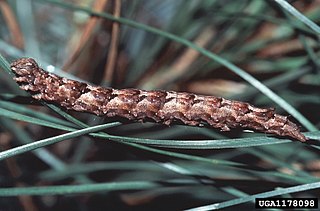
Zale submediana, the gray spring zale, is a moth of the family Noctuidae. The species was first described by Embrik Strand in 1917. It is found in the US from Wisconsin to Maine, south to New Jersey and in mountains to North Carolina.
Melitara prodenialis is a moth of the family Pyralidae described by Francis Walker in 1863. It is native to North America, where it is known from south-eastern New York to Florida along the Atlantic coastal plain, and west to eastern Oklahoma and north-central and south-eastern Texas. It is an introduced species in Hawaii. It is a special concern species in Connecticut.
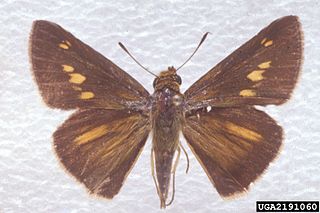
Euphyes dion, the Dion skipper or Alabama skipper, is a species of butterfly of the family Hesperiidae. It is found in scattered populations along the Atlantic coast of North America, from western Massachusetts and south-eastern New York south to north-eastern Florida, west to north-eastern Texas, and north to south-eastern North Dakota, northern Wisconsin, southern Ontario and southern Quebec. It is listed as a species of special concern in the US state of Connecticut.
Apodrepanulatrix liberaria, the New Jersey tea inchworm, is a moth in the family Geometridae. It was described by Francis Walker in 1860. It is found from extreme southern Quebec and southern Ontario southward into northern Florida and Mississippi. It is listed as endangered by state authorities in the US states of Massachusetts and Connecticut.

Glena cognataria, the blueberry gray moth, is a moth native to North America. It ranges from Florida to Nova Scotia and New Brunswick. Its larvae are hosted on blueberry. The habitat consists of bogs and pine barrens. It is listed as a species of special concern and believed extirpated in the US state of Connecticut.
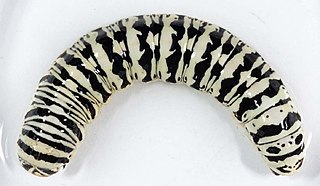
Cucullia speyeri, common names Speyer's paint, Speyer's cucullia or Speyer's hooded owlet moth, is a moth found in North America. It is found from Alberta and Montana to the Atlantic coast from New Hampshire to Virginia. It was described by Joseph Albert Lintner in 1874. In the US state of Connecticut, it is listed as a species of special concern and is believed to be extirpated. The habitat consists of open meadows, dry grasslands and native prairies.
Hydraecia immanis, the hop vine borer moth is a moth in the family Noctuidae native to North America. The species was described by Achille Guenée in 1852. It is listed as a species of special concern and is believed to be extirpated from the US state of Connecticut.

Sideridis maryx the maroonwing moth, is a species of moth native to North America. In the US state of Connecticut, it is listed as a species of special concern and is believed to be extirpated. The larval food plant is unknown, but it is suspected to be a specialist feeding on Arctostaphylos uva-ursi. The species was first described by Achille Guenée in 1852.
Apamea lintneri, the sand wainscot moth, is a species of moth native to North America. It is listed as a species of special concern in the US state of Connecticut. The species was described by Augustus Radcliffe Grote in 1873.
Photedes inops, the spartina borer moth, is a species of moth native to North America. The larvae are hosted on Spartina pectinata, apparently exclusively. It is listed as a species of special concern in the US state of Connecticut.












